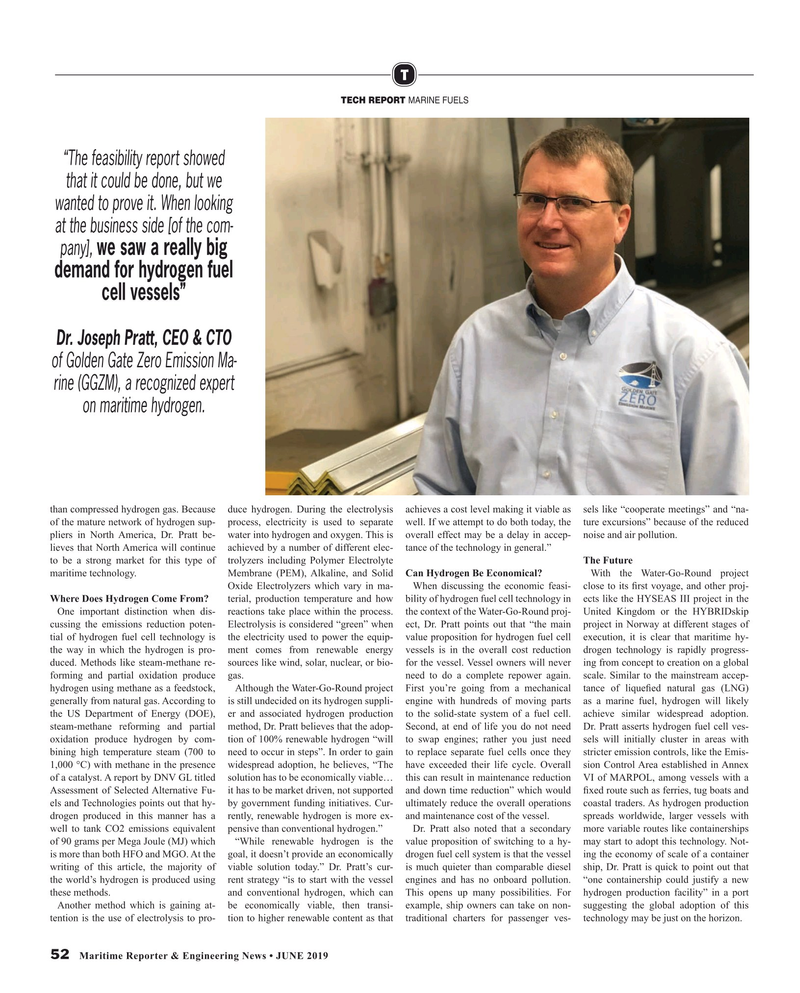
Page 52: of Maritime Reporter Magazine (June 2019)
80th Anniversary World Yearbook
Read this page in Pdf, Flash or Html5 edition of June 2019 Maritime Reporter Magazine
T
TECH REPORT MARINE FUELS “The feasibility report showed that it could be done, but we wanted to prove it. When looking at the business side [of the com- pany], we saw a really big demand for hydrogen fuel cell vessels”
Dr. Joseph Pratt, CEO & CTO of Golden Gate Zero Emission Ma- rine (GGZM), a recognized expert on maritime hydrogen. than compressed hydrogen gas. Because duce hydrogen. During the electrolysis achieves a cost level making it viable as sels like “cooperate meetings” and “na- of the mature network of hydrogen sup- process, electricity is used to separate well. If we attempt to do both today, the ture excursions” because of the reduced pliers in North America, Dr. Pratt be- water into hydrogen and oxygen. This is overall effect may be a delay in accep- noise and air pollution.
lieves that North America will continue achieved by a number of different elec- tance of the technology in general.” to be a strong market for this type of trolyzers including Polymer Electrolyte The Future maritime technology. Membrane (PEM), Alkaline, and Solid Can Hydrogen Be Economical? With the Water-Go-Round project
Oxide Electrolyzers which vary in ma- When discussing the economic feasi- close to its ? rst voyage, and other proj-
Where Does Hydrogen Come From? terial, production temperature and how bility of hydrogen fuel cell technology in ects like the HYSEAS III project in the
One important distinction when dis- reactions take place within the process. the context of the Water-Go-Round proj- United Kingdom or the HYBRIDskip cussing the emissions reduction poten- Electrolysis is considered “green” when ect, Dr. Pratt points out that “the main project in Norway at different stages of tial of hydrogen fuel cell technology is the electricity used to power the equip- value proposition for hydrogen fuel cell execution, it is clear that maritime hy- the way in which the hydrogen is pro- ment comes from renewable energy vessels is in the overall cost reduction drogen technology is rapidly progress- duced. Methods like steam-methane re- sources like wind, solar, nuclear, or bio- for the vessel. Vessel owners will never ing from concept to creation on a global forming and partial oxidation produce gas. need to do a complete repower again. scale. Similar to the mainstream accep- hydrogen using methane as a feedstock, Although the Water-Go-Round project First you’re going from a mechanical tance of lique? ed natural gas (LNG) generally from natural gas. According to is still undecided on its hydrogen suppli- engine with hundreds of moving parts as a marine fuel, hydrogen will likely the US Department of Energy (DOE), er and associated hydrogen production to the solid-state system of a fuel cell. achieve similar widespread adoption. steam-methane reforming and partial method, Dr. Pratt believes that the adop- Second, at end of life you do not need Dr. Pratt asserts hydrogen fuel cell ves- oxidation produce hydrogen by com- tion of 100% renewable hydrogen “will to swap engines; rather you just need sels will initially cluster in areas with bining high temperature steam (700 to need to occur in steps”. In order to gain to replace separate fuel cells once they stricter emission controls, like the Emis- 1,000 °C) with methane in the presence widespread adoption, he believes, “The have exceeded their life cycle. Overall sion Control Area established in Annex of a catalyst. A report by DNV GL titled solution has to be economically viable… this can result in maintenance reduction VI of MARPOL, among vessels with a
Assessment of Selected Alternative Fu- it has to be market driven, not supported and down time reduction” which would ? xed route such as ferries, tug boats and els and Technologies points out that hy- by government funding initiatives. Cur- ultimately reduce the overall operations coastal traders. As hydrogen production drogen produced in this manner has a rently, renewable hydrogen is more ex- and maintenance cost of the vessel. spreads worldwide, larger vessels with well to tank CO2 emissions equivalent pensive than conventional hydrogen.” Dr. Pratt also noted that a secondary more variable routes like containerships of 90 grams per Mega Joule (MJ) which “While renewable hydrogen is the value proposition of switching to a hy- may start to adopt this technology. Not- is more than both HFO and MGO. At the goal, it doesn’t provide an economically drogen fuel cell system is that the vessel ing the economy of scale of a container writing of this article, the majority of viable solution today.” Dr. Pratt’s cur- is much quieter than comparable diesel ship, Dr. Pratt is quick to point out that the world’s hydrogen is produced using rent strategy “is to start with the vessel engines and has no onboard pollution. “one containership could justify a new these methods. and conventional hydrogen, which can This opens up many possibilities. For hydrogen production facility” in a port
Another method which is gaining at- be economically viable, then transi- example, ship owners can take on non- suggesting the global adoption of this tention is the use of electrolysis to pro- tion to higher renewable content as that traditional charters for passenger ves- technology may be just on the horizon.
52 Maritime Reporter & Engineering News • JUNE 2019
MR #6 (50-57).indd 52 6/3/2019 3:35:19 PM

 51
51

 53
53
